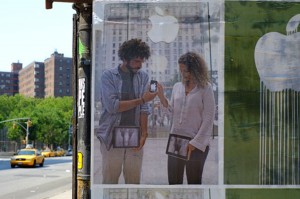29 April – 14 July 2013
.
(English below)
 21 世紀のストリート・アートは、理論的にも技術的にも統一されてはいない様々な積み重ねの混成からなるもので、その多くがアートの伝統において認められつつ あります。1960年代後半と1970年代初期のアイコン的なヒップホップ・カルチャーのタギングやグラフィティからの旅路を経て、アナキズムと反体制に もなお深く根ざしているストリート・アートは、アクティヴィズムや社会批判と同化することも多々あります。1990年代以降には、実際のコミュニティ、 様々な階層、独自のコミュニケーション手段や視覚的言語を伴った現実のムーブメントとしてストリート・アートは確立されるようになりました。それは誰もが 認める一定のスタイルや技法としてではなく、多岐にわたる実践の交配種、そして、グローバルな認知を得たシンボルやイメージやテーマを再び領有(アプロプ リエーション)するものとして認められています。
21 世紀のストリート・アートは、理論的にも技術的にも統一されてはいない様々な積み重ねの混成からなるもので、その多くがアートの伝統において認められつつ あります。1960年代後半と1970年代初期のアイコン的なヒップホップ・カルチャーのタギングやグラフィティからの旅路を経て、アナキズムと反体制に もなお深く根ざしているストリート・アートは、アクティヴィズムや社会批判と同化することも多々あります。1990年代以降には、実際のコミュニティ、 様々な階層、独自のコミュニケーション手段や視覚的言語を伴った現実のムーブメントとしてストリート・アートは確立されるようになりました。それは誰もが 認める一定のスタイルや技法としてではなく、多岐にわたる実践の交配種、そして、グローバルな認知を得たシンボルやイメージやテーマを再び領有(アプロプ リエーション)するものとして認められています。
そうした再領有のひとつに、フランスのアーチスト・Zevsによる《液状化 (Liquidated)》シリーズがあり、広く知られたブランドロゴを塗料の滴りによって融解させるこの作品は2000年代半ばから実践され、彼の名を 世界中に知らしめることになりました。McDonald’s、Louis Vuitton、Chanel、そしてGoogleなどの国際的な大企業のロゴは至るところに現れ、一日にそれを幾度となく目にすることはすでに当然のこ とになっていますが、強烈かつ繊細なイメージを創り出すZevsの巧みな筆さばきは、そうした大企業たちを滴る塗料とともに融解させ、その弱点を冗談めか しく仄めかし、その崩壊の予兆を示しつつ、20世紀から21世紀に至る消費主義を笑い飛ばすのです。
私たちはいわゆる「ブランド品」を購入 し所有できることが自由の象徴であり社会的地位と快適な生活の向上であると考えがちですが、消費主義・商品・ロゴに対するZevsの熱心な関わりは、その ような自由が幻想であることを最もさりげない方法で教えてくれます。つまり、私たちは大企業による搾取の虜となるために進化してきたのです。Zevsは消 費主義の心理的なリアリティを暴き出し、私たちを饒舌に欺く砂糖漬けの薄っぺらい幻想を粉砕します。滴り落ちるロゴは、まさしく死や痛みがそうであるよう に、もし陰鬱ではないとすれば、詩的で美しいものとして目に映るでしょう。それはとっさに傷口、滴る血、殺人を想わせるものであり、さらにはロゴの下に 往々にして生じる塗料だまりは、優美でもあり警鐘を鳴らすものでもあるのです。
The Containerでの展示では、Zevs自身がデザインしニューヨークの街頭に貼り出した《Adam & Eve》(2013)という題の二枚組ポスターを展示します。一方は「液状化」したApple社のロゴを描いており、他方は1526年にドイツ人画家ルー カス・クラナッハ(子)が制作したルネサンス期の絵画《Adam & Eve》を参照しています。一対の若い男女がどこかエロチックな仕草で智慧の実である林檎を分かち合う様子は、それがクラナッハの絵画のアイコニックな構 図であることにすぐに気付かせるものでしょう。しかしその文脈は現代的なものです。この一対の男女はニューヨークのアップルストアにおり、彼らの頭上には Apple社のロゴが浮かび、そのロゴはさらにガラスの壁に反射しています。彼らが分かち合う林檎はiPhoneに映し出されるApple社のロゴに過ぎ ず、元となった絵画で彼らの性器を覆い隠していた葉は、ネット上のポルノイメージから取った男女の性器を映したiPodへとすり替えられています。このア イロニーは強烈であり、挑発としても受け取られるものでしょう。
The Containerではさらにこのポスターの関連作品として、ジェッソに覆われた一台のラップトップ・コンピューターにApple社のロゴを投影したイン スタレーションを会場内に設置します。投影されたイメージは、一目にはApple社の実際の製品にあるような輝くロゴに見えますが、近づいて見ようとする と、自分自身の体が光を遮蔽するものとなり、上から投影されているロゴは消滅してします。ここから浮かび上がる寓意的なサブテキストは、消費主義がもたら す幻想を再び喚起し、それを決して手に入れることのできない存在として提示するのです。
The Containerにおけるこの展示は、東京ならびに関西のアンスティチュ・フランセのご厚意により実現したものです。アンスティチュ・フランセによる支援、ご尽力、資金援助にこの場を借りて感謝いたします。
.
Street Art in the 21st century is an amalgam of a wide range of disciplines, which are not unified theoretically or technically, and that, largely, progressed into the art establishment’s recognition. It has made quite a journey from the late 1960s and early 1970s’ iconic hip pop culture’s tags and graffiti paintings, and while still rooted in anarchism and the subversive, is often identified with activism and social criticism. Since the 1990s Street Art has also established itself as a real movement, with a real community, hierarchies, means of communication and a visual language. It has no particular agreed style however, or a certain technique, but is a hybrid of different practices and the reappropriation of globally recognizable symbols, images and themes.
Such reappropriation is the French artist Zevs’s series “Liquidated,” a sequence of familiar brand logos, dripping with paint, which he started to produce in the mid-noughties and earned him international recognition. The ubiquitous logos of major international corporations, which we are so accustomed to see dozens of times a day, such as McDonald’s, Louis Vuitton, Chanel, and Google, among others, are treated with Zevs’s painting technique to produce visually compelling and sensitive images, dripping with paint, playfully hinting infirmity, and suggesting disintegration, while deriding the 20th and 21st centuries’ obsession with consumerism.
It is common for us to think that buying power and the ability to possess “designer goods” symbolize our freedom, elevate our social status and comfort, but Zevs’s obsession with consumerism, objects and logos, teaches us in the most subtle of ways that this freedom is an illusion—we have evolved to be the prisoners of these corporations and their exploitation. Zevs exposes the psychological reality of consumerism and shatters the paper-thin illusion that sugarcoats them to deceive us so eloquently. Visually, the dripping logos are beautiful and poetic, if not morbid, just as pain and death usually are. They immediately recall a wound, dripping blood, a murder, and the puddle of paint that often collects beneath the logos is both elegant and alarming.
The exhibition at The Container showcases a recent poster diptych Zevs has designed and pasted on the streets of New York City, entitled Adam & Eve (2013). One of the images of the diptych depicts a “liquidated” version of Apple’s logo, while the other makes a reference to the renaissance painting Adam and Eve from 1526 by the German painter Lucas Cranach the Younger. We instantly recognize the iconic composition of Cranach’s painting, a young man and a woman, somewhat erotically, sharing an apple, the fruit of wisdom. The context, however, is new—the couple is situated in the Apple store in NYC, with the company’s logo hovering over their heads and reflected again on the glass walls. The apple they are sharing is none than Apple’s logo illuminated from an iPhone, while the leaves that conceal the genitals in the original painting have been replaced by iPads casting male and female genitals taken from internet porn. The irony is fervent and thought provoking.
In addition to the posters, Zevs is also mounting a related installation inside the container: a laptop, covered with gesso and the Apple logo projected on it. In first view, the projected image seems to be an illuminated logo, similarly to the one you would find on some of the corporation’s actual laptops, though as one approaches the treated laptop for closer observation, one’s body serves as a partition and the logo, which is projected from above, disappears. The allegorical subtext that emerges evokes again the illusion consumerism encompasses, and presents it as an unattainable entity.
The exhibition at The Container would not have been possible without the kind help and support of Institut français du Japon – Tokyo and Kansai. We are grateful for their assistance, hard work and funding.